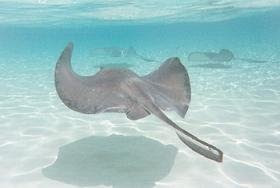 majority of their time inactive, partially buried in sand, often moving only with the sway of the tide. The stingray's coloration commonly reflects the seafloor's shading, camouflaging it from predatory sharks and larger rays. Their flattened bodies are composed of pectoral fins joined to their head and trunk with an infamous tail trailing behind.
majority of their time inactive, partially buried in sand, often moving only with the sway of the tide. The stingray's coloration commonly reflects the seafloor's shading, camouflaging it from predatory sharks and larger rays. Their flattened bodies are composed of pectoral fins joined to their head and trunk with an infamous tail trailing behind.While the stingray's eyes peer out from its dorsal side, its mouth, nostrils, and gill slits are situated on its underbelly. Its eyes are therefore not thought by scientists to play a considerable role in hunting. Like its shark relatives, the stingray is outfitted with electrical sensors called ampullae of Lorenzini. Located around the stingray's mouth, these organs sense the natural electrical charges of potential prey. Many rays have jaw teeth to enable them to crush mollusks such as clams, oysters, and mussels.
When they are inclined to move, most stingrays swim by undulating their bodies like a wave; others flap their sides like wings. The tail may also be used to maneuver in the water, but its primary purpose is protection.
The stingray's spine, or barb, can be ominously fashioned with serrated edges and a sharp point. The underside may produce venom, which can be fatal to humans, and which can remain deadly even after the stingray's death. In Greek mythology, Odysseus, the great king of Ithaca, was killed when his son, Telegonus, struck him using a spear tipped with the spine of a stingray.via
Other picture of stingray.













